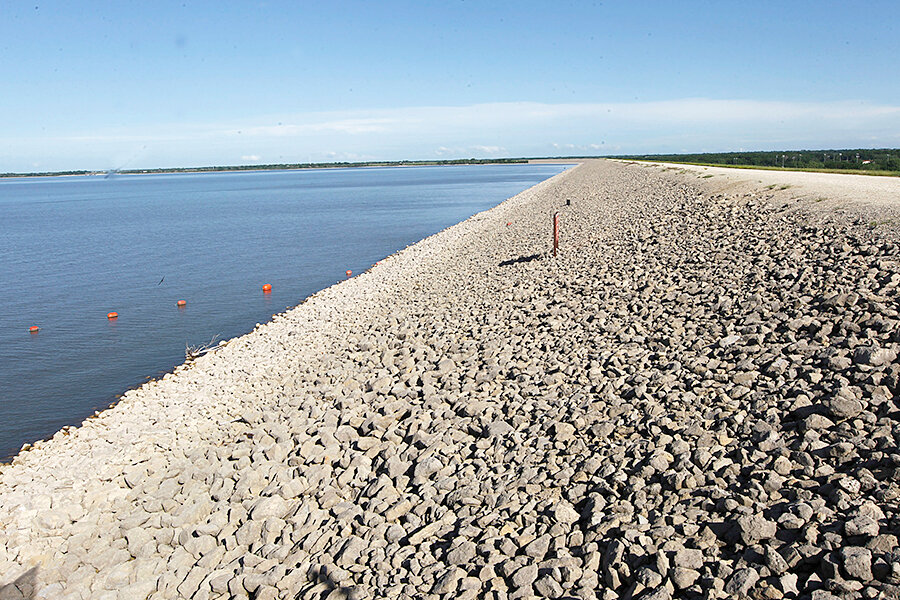A spike in man-made quakes: Has Kansas got an answer?
Loading...
This time last year Kansas found itself facing an issue states from Ohio to Texas had been battling for decades: large earthquakes were shaking the state, triggered by the injection of wastewater and chemicals – left over from oil and gas drilling – deep into the ground.
As other states have seen their "man-made" earthquakes increase in size and frequency, Kansas has seen the numbers in its most seismically active areas go in the opposite direction. At least for now.
The Sunflower State credits its modest victory to advances in science, as well as learning from the struggles of other states. While experts caution that the geology of each state is unique, Kansas's tentative success could outline a path for its neighbors to reduce quake activity.
"This issue arose in Kansas quite a while after it had shown itself elsewhere, particularly in Oklahoma," says Rex Buchanan, interim director of the Kansas Geological Survey.
Just over the course of one turbulent year in Kansas, Mr. Buchanan thinks the science has progressed in leaps and bounds.
"We had the benefit of watching what happened in other states and hearing what other people are learning," he adds. "In a lot of respects I'd say we were the beneficiary of coming along in this process a little bit late."
Earthquake activity sharply increased in the central and eastern US in 2009, an increase the United States Geological Survey (USGS) attributed, in part, to industrial wastewater injection.
From 4 quakes a year to 154
From 2000 to 2013 Kansas never saw more than four earthquakes magnitude 2.5 or greater a year. But in 2014 that number jumped up to 154, including nine quakes of a magnitude 3.5 or more.
While the early results of placing a wastewater injection limit on wells have been encouraging, scientists are far from convinced there is a national one-size-fits-all solution.
"Each state is unique and will face different challenges regarding this issue as it is still developing," writes Ryan Hoffman – director of the Kansas Corporation Commission, the agency that issued the March 2015 order to put a cap on well injections – in an e-mail to the Monitor.
"Rather than approaching the issue on a statewide or national scale, it is important to identify the areas more susceptible and take whatever actions are necessary for that specific area," he adds.
Results have been promising in Kansas's Harper and Sumner counties, which are in the Arbuckle Shale that straddles the Kansas-Oklahoma border – the area most prone to seismic events.
In the 290 days before the rule went into effect the Harper and Sumner experienced 165 earthquakes (56 greater than magnitude 3). In the 290 days after the rule went into effect the two counties experienced 138 earthquakes (34 greater than magnitude 3), according to USGS data.
But with an array of other variables at play, scientists like Buchanan are hesitant to declare the injection limit as responsible. Some are even hesitant to acknowledge there has been a decrease, given the relatively small sample size.
There are multiple other potential causes, he says, ranging from a reduction in natural seismic activity to less drilling activity due to a sharp drop in oil prices.
A case for well injection limits
A stronger case can be made for the injection limit when comparing Kansas to its neighbor. In Oklahoma, the number of earthquakes of magnitude 2.7 or stronger increased by 10 percent from mid-2014 to mid-2015, according to the Associated Press, while quakes of that strength decreased by 60 percent over the same period Kansas wide. So far in January, Oklahoma has experienced 88 earthquakes magnitude 2.7 or stronger.
There are a number of exacerbating factors to consider. Oklahoma has far more disposal wells than Kansas and a lot more wastewater already in the ground from years of injections. Still, when Kansas decided to implement its disposal limit in March 2015, Oklahoma went in a different direction.
Instead of placing a limit on the volume of wastewater companies could inject into the wells in the Arbuckle, the state – heeding warnings from seismologists about the dangers of injecting wastewater too deep – issued an order to avoid the Arbuckle’s "basement," putting few limits on the volume of water companies could dispose of.
State regulators have since amended that order. Earlier this month, after a dozen earthquakes hit an Oklahoma City suburb in less than a week, the state regulatory agency ordered operators at some injection wells to reduce wastewater disposal volumes.
"Truthfully I don't think Oklahoma regulators were aware of all [seismic] fault lines Oklahoma had, and with more investigation they’ve found more," says Carol Booth, a spokesperson for the Interstate Oil and Gas Compact Commission, a multi-state agency advocating for environmentally responsible natural resource extraction.
"Now they have a full scope of what they have to their knowledge right now and will put in the regulations needed to prevent further [seismic] activity," she adds.
But while it may appear that Oklahoma is following Kansas's lead, experts there say they've only been the beneficiaries of years of trial-and-error in other states.
Scientists have been aware of man-made earthquakes (known as "induced seismicity") since the late 1960s, but the issue has taken on a new importance in recent years. A report Buchanan co-authored that comprehensively links wastewater injections to induced seismicity came out last September.
But the social, political, and geological variety in drill sites across the country gives experts pause when considering if Kansas could be considered a model for other states to follow.
"All of those things are unknowns," says Buchanan. "At this point I think the jury's still out."
Correction: This article was updated to correct Carol Booth's name.








